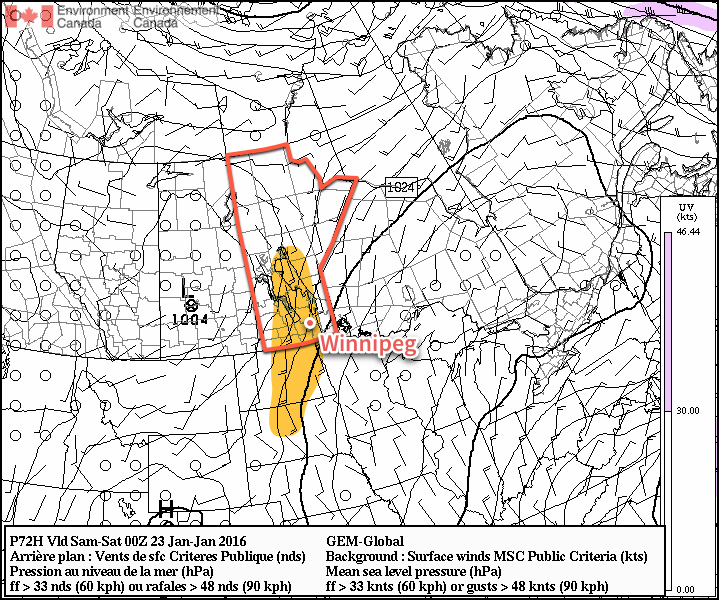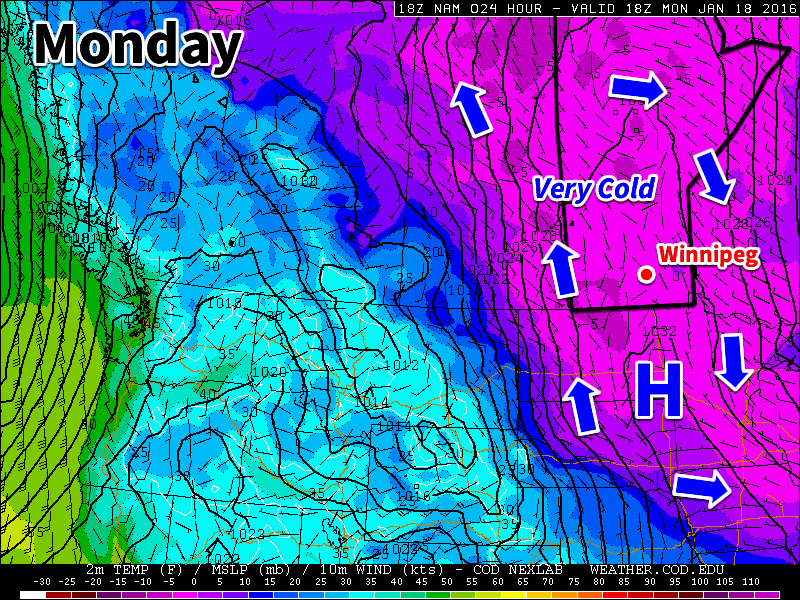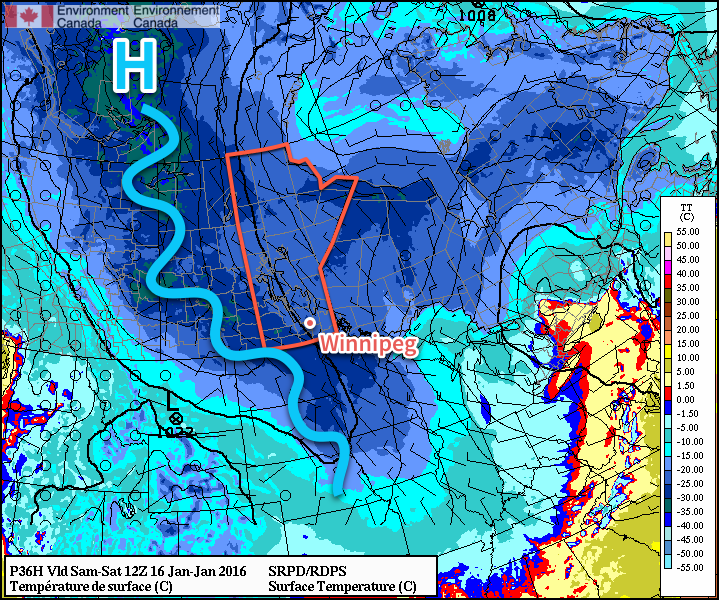Welcome to A Weather Moment’s look back at the weather in Winnipeg for 2015. In this update, we’re going to take a look at how temperature & precipitation developed through the year and how 2015 stacked up against the history books. In another post coming soon, we’ll take a look at the top 10 weather events of 2015!
| Category | 2015 Average or Total | Rank (since 1873) |
|---|---|---|
| High Temperature | 10.1°C | 7th warmest (tie) |
| Mean Temperature | 4.2°C | 9th warmest |
| Low Temperature | -1.7°C | 11th warmest (tie) |
| Rainfall | 450.9 mm | 38th rainiest |
| Snowfall | 116.7 cm | 64th least snowy |
| Precipitation | 529.6 mm | 61st wettest |
Temperature: Chilly Start With A Mild Finish
With a mean temperature of 4.2°C at the Winnipeg International Airpot, 2015 was the 9th warmest year on record since 1873 in Winnipeg and the warmest since 2012. This was 1.3°C warmer than the 1981-2010 normal of 2.9°C. In addition, daily high temperatures averaged 10.1°C, only the 9th time since 1873 that this value was in the double digits. The graph below shows how each month fared compared to normal and how the year-to-date average changed throughout the year.
Only three months were colder than the 1981-2010 normals: February (-5.7°C), May (-0.4°C) and August (-0.2°C). February was by far the most abnormally cold month, averaging -19.2°C, 5.7°C below normal and the 27th coldest February since 1873. It was also the 3rd coldest February since 1980 and the 11th coldest February in the last century. Only 6 days rose above -10°C, tied 10th least since 1873. Interestingly, it was the 10th colder than normal February in the last 11 years.
Six months in 2015 averaged over 2°C above normal: December (+5.4°C), November (+3.7°C), September (+2.9°C), March (+2.8°C), January (+2.7°C) and October (+2.0°C). There was a streak of four months averaging over 2°C at the end of the year. In fact, the September to December period was the third warmest on record since 1872 with an average of 3.5°C. Only 1931 (avg 4.1°C) and 1923 (avg 3.7°C) were warmer. The 1981-2010 normal is 0.0°C.
| Rank | Average Mean Temperature | Year |
|---|---|---|
| 1 | 5.4°C | 1987 |
| 2 | 5.3°C | 1931 |
| 3 | 4.7°C | 1878 & 1998 |
| 5 | 4.6°C | 2012 |
| 6 | 4.5°C | 2006 |
| 7 | 4.4°C | 1981 |
| 8 | 4.3°C | 1999 |
| 9 | 4.2°C | 2015 |
| 10 | 4.1°C | 2010 |
Other stats included:
- 12 days above 30°C at the airport (normal is 14 days) and 16 days at The Forks
- 45 days below -20°C at the airport (normal is 53 days) and 33 days at The Forks
- 3 new record highs (13.2°C on Mar 14, 24.8°C on Apr 15 and 5.6°C on Dec 9) and 3 new record high minimums (21.2°C on Aug 15, 21.0°C on Sep 3 and 5.3°C on Nov 16)
- NO new record lows or low maximums in 2015
Precipitation: Highly Variable & Above Normal
2015 was a wet year in the Red River Valley. In Winnipeg, 450.9 mm of rain fell at the airport, about 23 mm above normal. This was on the low end of things because many stations inside the city received over 500 mm. 544.0 mm of rain fell in south St. Vital, the rainiest year since 2010. August was the rainiest month with 148.8 mm in Charleswood, 140.5 mm in south St. Vital and 107.8 mm at the airport. The rainiest day of the year in the south end was August 22 with 68.8 mm in Charleswood and 54.5 mm in south St. Vital. September 4 was the airport’s rainiest day with 41.1 mm. These rainy days were the consequence of heavy thunderstorms.
In terms of snowfall, generally 115 to 120 cm or so fell in Winnipeg. This is basically bang on normal. More than a third of this snow fell in December with 44.0 cm, the 12th snowiest December on record since 1872. In fact, about 40 cm fell in just 8 days from December 16 to 23.
Combining rainfall with melted snowfall gives a total precipitation amount for the year. About 530 mm fell in Winnipeg officially, which is within a few mm of normal (note that I use The Forks station in the winter months and the airport station in the warmer months because the airport station underestimates winter precipitation). Again, most parts of the Red River Valley saw much more. 632.3 mm of precipitation fell in south St. Vital, about 80 mm more than in 2014 and the most since 2010. Widespread totals over 600 mm occurred south and southeast of the city. Locally over 700 mm was recorded at some CoCoRaHS stations in the Steinbach area. The higher totals were seen in areas that were hardest hit by heavy thunderstorms over the summer.
Other stats included:
- 3 new record high rainfalls (31.3 mm on May 17, 38.4 mm on Aug 22 and 41.1mm on Sep 4)
- 1 new record high snowfall (18.0 cm on Dec 16)
Wrapping Up 2015
Overall, it was a very warm and wet year in the Red River Valley.
The 30-year normal temperature in Winnipeg now stands at 3.0°C (1986-2015 period), tied with the 1984-2013 period for warmest 30-year period since 1872. This means we are currently the warmest we have been in at least 140 years.
It was also an active year for thunderstorms across southern Manitoba with numerous severe hail and tornado events. Stay tuned over the next couple weeks for the top 10 events and stories of the year which will summarize the biggest extremes we saw in 2015.




